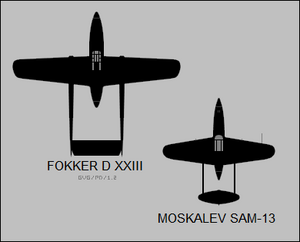Engineering:Moskalyev SAM-13
| SAM-13 | |
|---|---|

| |
| Role | Twin-engined fighter |
| Manufacturer | Voronezhskoye Aktsionernoye Samolyotostroitelnoye Obshchestvo, Voronezh |
| Designer | Aleksandr Sergeevich Moskalyev |
| First flight | 1940 |
| Number built | 1 |
The Moskalyev SAM-13 (Russian: Москалев САМ-13) was a prototype twin-engined single-seat low-wing fighter built in the Soviet Union in the 1930s.
Design and development
The design of the SAM-13 followed similar principles to that of the Fokker D.XXIII: to build a lightweight twin-engined fighter with benign single-engined flying characteristics. Moskalyev's design could well have been influenced directly by the D.XXIII, which had been exhibited at the 1938 Paris Salon, differing mainly in size.[1]
The SAM-13 was built largely from wood, with steel fittings in high stress areas and welded steel-tube engine mounts. It was powered by two 220 hp (160 kW) Voronezh MV-6 6-cylinder, air-cooled, inverted in-line engines mounted at the front and rear of the fuselage nacelle, driving 2-bladed, variable pitch propellers.[1]
The sharply tapered wings supported tail-booms which in turn supported the tailplane, elevators, single centrally-mounted fin and rudder. The wings also housed the retractable main undercarriage units which retracted inwards. The nose undercarriage was attached to the front engine mounting and retracted rearwards.[1]
Armament of the SAM-13 was intended to be 4x 7.62 mm (0.30 in) ShKAS machine-guns: two in the fuselage top decking firing through the propeller disc, and one at each end of the wing centre-section.[1]
Operational history
First flown in 1940 by Nikolay D Fikson, the SAM-13 proved difficult to handle, requiring long runs to take off and land, with poor climb performance and low ceiling.[1]
After the first flight and subsequent tests, the poor flying qualities of the SAM-13 were being addressed when the Germans invaded during Operation Barbarossa. By Spring 1941 the SAM-13 was undergoing tests at LII, piloted by Mark L Gallai, even being entered for a summer air race. All flying ceased after the German invasion, which prompted destruction of the aircraft.[1]
Specifications (SAM-13)
Data from Soviet X-Planes[1]
General characteristics
- Crew: 1
- Length: 7.85 m (25 ft 9 in)
- Wingspan: 7.3 m (23 ft 11 in)
- Wing area: 9 m2 (97 sq ft)
- Empty weight: 754 kg (1,662 lb)
- Gross weight: 1,183 kg (2,608 lb)
- Powerplant: 2 × Voronezh MV-6 6-cylinder air-cooled inverted in-line engines, 160 kW (220 hp) each
- Propellers: 2-bladed variable-pitch propellers, 2.2 m (7 ft 3 in) diameter
Performance
- Maximum speed: 463 km/h (288 mph, 250 kn) at sea level; 680 km/h (420 mph; 370 kn) at 4,000 m (13,000 ft) (estimated)
- Landing speed: 125 km/h (78 mph; 67 kn)
- Range: 1,370 km (850 mi, 740 nmi) estimated
- Service ceiling: 10,000 m (33,000 ft) estimated
- Wing loading: 131 kg/m2 (27 lb/sq ft)
- Power/mass: 0.37 kW/kg (0.169 hp/lb)
Armament
- 4x 7.62 mm (0.300 in) ShKAS machine-guns
References
Further reading
- Gordon, Yefim; Medvedʹ, Alexander; Khazanov, Dmitri (1999). Soviet combat aircraft of the Second World War.. Leicester: Midland. ISBN 1-85780-084-2.
- Shavrov, V.B. (1988). Istorii︠a︡ konstrukt︠s︡iĭ samoletov v SSSR, 1938-1950 gg. : materialy k istorii samoletostroenii︠a︡ (2-e izd., ispr. ed.). Moskva: Mashinostroenie. ISBN 5-217-00477-0.
- Šavrov, V.B. (2002). Istorija konstrukcij samoletov v SSSR do 1938 g. (5. izd., ispr. ed.). Moskva. ISBN 5-217-03112-3.
External links
 |

